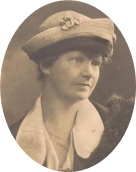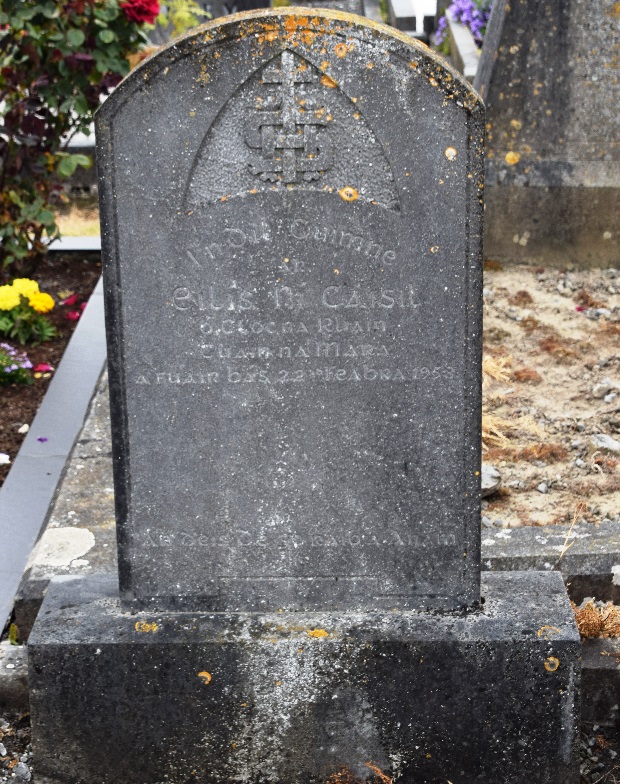Alice Mary Cashel (1878 - 1958)
Irish Republican, Teacher, Founding member of Cork Cumann na mBan,
Dail Eireann Courts Judge and Galway County Councilor
 Early Years.
Early Years.
Alice Mary Cashel was the seventh child and fifth daughter born to Blenner Hassett Cashel and Maria Agnes Cashel (nee Lyons) in Parsonstown, King's County (now Birr Co. Offaly) on July 17, 1878. Of the eleven children born to the Cashel’s, two of the six girls and four of the five boys, succumbed in their early childhood to one or more of the contagious diseases rampant throughout Ireland at that time.
After Alice's mother died in 1896, Blenner Cashel married Marion McSwiney with whom he had a daughter.
Blenner Cashel worked his whole career for the Great Southern and Western Railway (GSWR) at various locations serviced by the railway's main network of stations and branch lines between Dublin, Limerick, and Cork. At the time of Alice's birth, he was the station master at the Seefin Railway Station located on one of the branch lines near Birr in Co. Offaly.
Although apolitical in his everyday dealings he, nonetheless, was a reliable cog in the wheel of Britain’s colonial apparatus in Ireland as evidenced by his journey to London in 1882 to testify against Thomas Walsh of London who was charged with sending arms to individuals in Ireland. Blenner reported how he found cases containing arms that had arrived at Limerick station in Dec 1881. Later on in life, in what could be considered a rebuke of the same colonial rule he had so faithfully served, he supported his three daughter --- Agnes, Alice and Madeline --- when they joined Sinn Fein, an action diametrically at odds with the perceived legitimacy of British rule in Ireland.
Alice and her sisters were educated at a Girls Model School in Limerick. Model schools were teacher-training institutions associated with elementary school where student teachers could practice their skills and gain experience in leading a class.
After receiving her teaching certificate Alice taught liberal arts courses at the Mary Immaculate Training College in Limerick and afterwards at St. Agnes Secondary Training School in Cork. During her early years as a teacher she studied for a degree from the Royal University of Ireland. In 1917 she took up a teaching position at St. Ita's School for Girls School in Cork. The school was founded by Alice's close friends, Mary, and Annie MacSwiney's. It was modeled after Padraic Pearse's St Enda's School for boys in Dublin.
Nationalistic Activism
Alice was the only member of her family who spoke Irish, an accomplishment attributable to her desire to speak Ireland's native language. The means by which she mastered that task was the Gaelic League she presumably joined after the Cork branch was founded by Liam de Róiste in 1899. The League was founded in 1893 by Douglas Hyde and others to de-anglicize Ireland by reviving its own unique language and culture so long suppressed by conquest. In a second significant initiative that brought her deeper into the Nationalist camp was her membership of Arthur Griffith's Sinn Fein party in 1907. Griffith's intent was to bring disparate Nationalist factions together into a cohesive political organization focused on achieving Home Rule for Ireland within the constraints of the United Kingdom of Great Britain and Ireland. A monarchist by inclination, Griffith did not subscribe to the principles of Irish republicanism, i.e., complete separation from England.
As a member of Sinn Fein, Alice worked with such notable as Terence MacSwiney, Tomas MacCurtain and Dr Alice Barry. Uneasy with the lack of interest by the general public in the Sinn Fein message, Alice confronted MacSwiney who assured her that "the people were all right, they were Fenians at heart". With time on her hands and believing that her spare time could be utilized elsewhere to advance the Home Rule agenda, she teamed up with Madeline O'Hegarty, Mary MacSwiney, Annie MacSwiney, and other activists to found the Cork branch of Cumann na mBan (CnamB). In all, 100 or so women joined the organization at its inaugural meeting on June 8, 1914.
Alice was also a member of the Munster Women's Franchise League (MWFL) founded in Cork in 1911. She and Mary MacSwiney served on its Executive Council until 1914 when they and others Nationalist activists left to found CnamB. The MWFL accused them and the women of CnamB of being handmaids to the Irish Volunteers, an affront that caused unnecessary friction and animosity between the groups.
In addition to the many organizations to which she was affiliated, Alice was, according to her witness statement to the Bureau of Military History dated February 6, 1950, the secretary for the inaugural meeting of the Cork Corps of the Irish Volunteers in December of 1913. In that statement she erroneously stated that the Cork branch of CnamB branch was founded before the Cork Corps if Irish Volunteers. Considering the time lapse between the event of 1914 and her witness statement in 1950 its understandable how she could not recall the actual sequence of events.
In 1914, when Sean O'Hegarty was debarred from living in Cork City by the British under provisions of the Defense of the Realm Act for seditious activities, Alice gave him a cottage she owned in Ballingeary (located west of Cork City where he lived with his wife, Madeline, for a number of years.
In the Irish Republican Camp.
In September of 1914, John Redmond cajoled the vast majority of Volunteers, 150,000 or so, to support the British war effort and take their place alongside the Ulster Volunteers in the trenches on Western Front trenches and on the beaches of Gallipoli. The 13,000 who ignored his call were Irish Republicans, more inclined to fight their own freedom than heed the war cry of the Empire. Cumann na mBan also split with fewer joining the British war effort. Alice sided with the Republican side.
Prior to the Easter Rising of 1916, Alice was living in Limerick. In the week before the Rising, she went to Ballingeary to spend Easter with the O'Hegarty's. It was there that she learned of the planned Rising from O'Hegarty. On Holy Thursday she was ordered to report to the Volunteers Headquarters in Cork. On arriving there she was tasked with hiring two cars that were to be used to transport some of the arms unloaded from the Aud. She was not able to get any cars as the garage was closed for Good Friday. The situation worsened after that with the aborted landing of arms from the Aud, the arrest of Roger Casement and the countermanding orders by the Volunteer's Chief of Staff, Eoin McNeill, to stand down. Consequently, nothing happened in Cork.
The following August Alice embarked on a visit to New York on behest of Sean O'Hegarty to brief John Devoy on the Rising. O'Hegarty had prepared a written report to be handed over to Devoy. Knowing that she would be interrogated and searched by the British on departure she memorized the contents of O'Hegarty's report before destroying it. Finding nothing on her person she could depart. On arriving in the New York, she reconstructed O'Hegarty's report from memory and delivered it to Devoy who on receipt bitterly complained about the organization in Ireland, particularly Roger Casement. She returned to Ireland in January of 1917 and took up a teaching position in St Ita's School for Girls in Cork.
In 1918, at the behest of her brother-in-law, James O'Meara she canvassed for the Sinn Fein candidate, Patrick McCartan, in the South Armagh by-election. Although he lost that election, he went on to win another by-election later that year in Tullamore. After the South Armagh by-election, she was appointed an organizer for Cumann na mBan and forthwith organized a branch in Newry. As the result of a subsequent meeting with de Valera and Sean McEntee who were organizing throughout the northern counties for the General Election scheduled for December of that year, she was tasked by them to organize Cumann na mBan branches around Donegal in their wake. She also worked on the Tyrone and Cavan election and helped McEntee and Count Plunkett canvass in Monaghan.
In mid-August of 1918 she was directed by the Sinn Fein HQ to go to Clifden in Connemara Co. Galway to organize a branch of Cumann na mBan. She was instructed, as were other organizers throughout Ireland, to read in public the Sinn Fein election manifesto on August 15th. During the reading, the Royal Irish Constabulary (RIC) dismantled the platform set up in the town center for the occasion. Not to be deterred she led the townspeople who had come to listen to the d'Arcy monument on Cashel Hill located on the outskirts of the town, where she with the help of a local Sinn Fein official finished reading the manifesto. After that she "went on the run" staying in safe houses before having to flee Clifden to escape the RIC who were closing in. She did so by cycling to Galway (a 50 mile trek) during the night on a bicycle given to her by Countess Markievicz. Always one step ahead of the RIC, she continued with her organizing work in Galway, Mayo, Leitrim, and Donegal before winding up in Dublin in April of 1919where she worked at the Cumann na mBan headquarters while recouping from an illness, possibly caused by her hectic and harrowing schedule.
In the throes of Rebellion
In the meantime, the first Dail Eireann was established on January 21, 1919 after the lopsided win by Sinn Fein in the General Election of December 1918. Coincidently, or not, the Irish War of Independence started on the same day with the Soloheadbeg ambush in Tipperary where two RIC constables were killed.
Later, in the Summer of 1919, Alice took up residence with her sister and brother-in-law, James O'Meara. at their home, Cashel House, in Cashel near Clifden in Co. Galway. When the O'Meara's went to the United States later that year to promote the Irish Republic, Alice took over the management of the family’s fisheries business. However, her reputation had proceeded her to Cashel owing to her earlier run in with the RIC in Clifden, and as a result was suspected by the RIC of receiving guns from O'Meara in the United States. They surmised that she was using one of the business's fishing boats to bring them ashore from passing ships during the night. Unable to catch her in the act they raided the house in April of 1920 and took her into custody. She was brought to the Renmore prison in Galway. Unable to find anything to incriminate her she was released after a week. On release she insisted that she be driven back to Cashel to where she was arrested without cause. They relented and drove her back.
On her return to Cashel, Alice was greeted with a welcoming reception and a bonfire on Cashel Hill. She was also co-opted onto the Clifden District Council and later that Summer was appointed the Council's representatives to the Galway County Council and subsequently elected one of the Council's vice-Chairpersons. During this same time period she and Katie Kelly, a veteran of the Easter Rising, formed a company of Irish Republican Volunteers in Cashel. The Volunteers were responsible for maintaining order and for controlling the poteen trade.
In June of 1920 the Dail Courts were established replacing the Arbitration Courts established by the nascent Dail Eireann in June of 1919. At a subsequent convention in Galway Alice was elected a Parish Judge for Connemara. She presided over land disputes, petty larceny, and other misdemeanors at various locations, sometimes openly in the daytime and at other times at secret locations at midnight for the more serious cases.
By the Summer of 1919, the Galway County Council was in the hands of Sinn Fein. After meeting with Kevin O'Higgins in Dublin. Alice returned to Galway with instructions on how to proceed to ensure that Sinn Fein's authority and agenda were recognized and followed.
In March of 1920, the Black and Tans began to arrive in Ireland to help the RIC defeat the Irish Republican Army (IRA), the Volunteers fighting for Irish freedom and to reverse the diminishing reach and authority of Britain's government institutions throughout Ireland attributable to the rise of Irish Republic and its fledging institutions.
Alice became a target of the Black and Tans in the latter months of 1920 because of her anti-British stance and for representing Sinn Fein on the Galway County Council. By then outbuildings of Cashel House were occupied by contingent of British soldiers who complained that Alice would not grant them access to the residence. When they left, the Black and Tans raided the place and arrested Alice, presumably because of the disrespectful way she treated the British soldiers. Expecting such a raid she was prepared and, as they were sneaking up on the house, escaped through a back window. She lay low on Cashel Hill until Kate Kelly took her into hiding in her home.
Unable to return to Cashel House Alice returned to Dublin and from there heading to Paris to take care of family business. Enroute through London she saw a newspaper heading stating that Galway County Council had passed a resolution pledging allegiance to the British crown. On arrival in Paris she met with Sean T. O'Kelly to discuss how to respond. Within a few days she returned to Dublin and from there headed to Galway to discover that the action taken some Unionist Council members was unsound as there was no quorum therefore, the resolution was invalid. In the process of undoing the damage caused by the bogus resolution Alice was arrested and sentenced to six months in jail. Neither she nor her fellow prisoner, Dr. Ada English recognized the court stating that "I am carrying out the instruction of the only Government I know".
After her release she returned to Dublin where she worked for Erskine Childers on publicity related pamphlets under the auspices of the Department of Publicity. After Childers departed for London in October of 1921 with the Irish Treaty Delegation, Alice was appointed secretary to the Cumann Léigheacht an Phobail (Popular Lecture Society) referenced in Erskine Childers papers. The Society was headed by Alice Stopford Greene.
After word of the Treaty arrived Alice informed Austin Stack of her opposition to the terms the Treaty and offered her resignation. She was ordered by Stack to continue with her duties for the present. After the bombing of the Four Courts on June 22, 1922, she ceased all work and communications with the British backed authorities in Dublin.
She supported the Republicans in the ensuing Treaty causative Civil War. No account of her involvement is available.
Later Life
In 1935 Cashel published a novel, The Lights of Leaca Bán, which was widely used in Irish schools. The story involves a family in the west of Ireland in the period leading up to and during the 1916 Easter Rising.
Alice Mary Cashel died on 22, February 1958 at the Regional Hospital in Galway. She was buried with honors on February 25, 1958, in New Cemetery, Bohermore, Galway.
Contributed by Tomás Ó Coısdealbha
Cemetery
Bohermore Cemetery
Tuam Rd., Galway, Co. Galway
HEADSTONE


